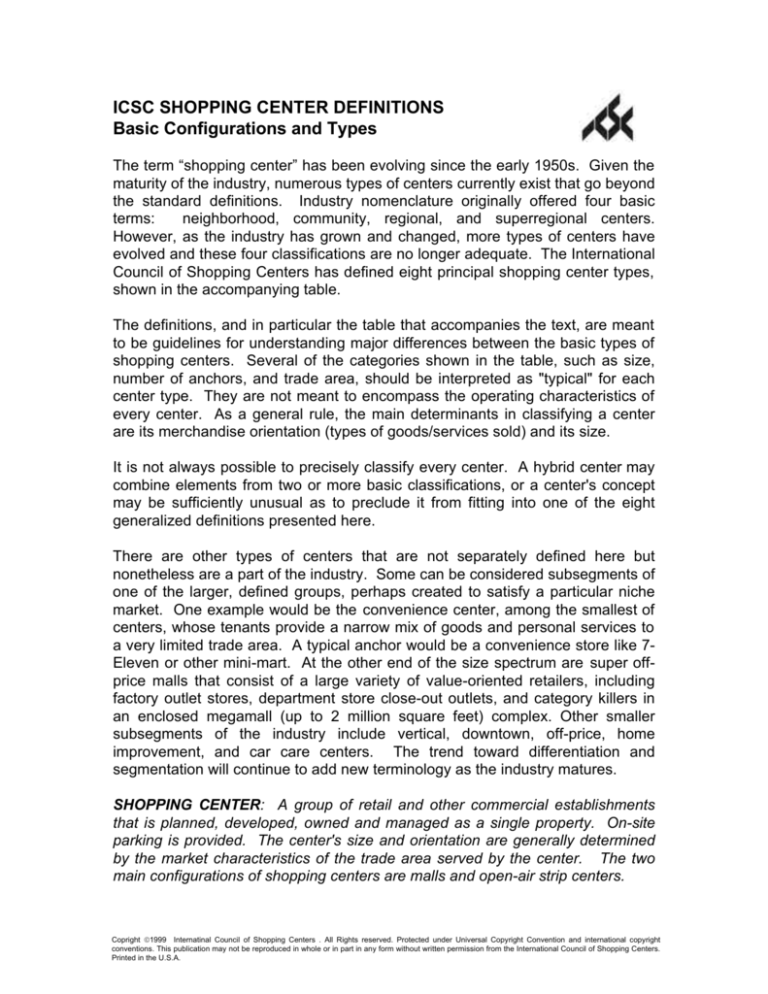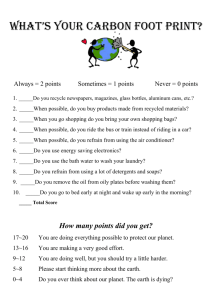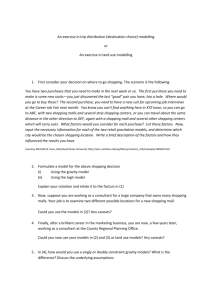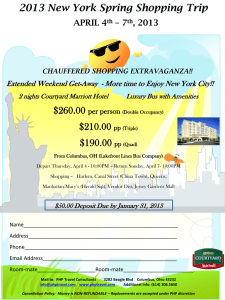
ICSC SHOPPING CENTER DEFINITIONS
Basic Configurations and Types
The term “shopping center” has been evolving since the early 1950s. Given the
maturity of the industry, numerous types of centers currently exist that go beyond
the standard definitions. Industry nomenclature originally offered four basic
terms:
neighborhood, community, regional, and superregional centers.
However, as the industry has grown and changed, more types of centers have
evolved and these four classifications are no longer adequate. The International
Council of Shopping Centers has defined eight principal shopping center types,
shown in the accompanying table.
The definitions, and in particular the table that accompanies the text, are meant
to be guidelines for understanding major differences between the basic types of
shopping centers. Several of the categories shown in the table, such as size,
number of anchors, and trade area, should be interpreted as "typical" for each
center type. They are not meant to encompass the operating characteristics of
every center. As a general rule, the main determinants in classifying a center
are its merchandise orientation (types of goods/services sold) and its size.
It is not always possible to precisely classify every center. A hybrid center may
combine elements from two or more basic classifications, or a center's concept
may be sufficiently unusual as to preclude it from fitting into one of the eight
generalized definitions presented here.
There are other types of centers that are not separately defined here but
nonetheless are a part of the industry. Some can be considered subsegments of
one of the larger, defined groups, perhaps created to satisfy a particular niche
market. One example would be the convenience center, among the smallest of
centers, whose tenants provide a narrow mix of goods and personal services to
a very limited trade area. A typical anchor would be a convenience store like 7Eleven or other mini-mart. At the other end of the size spectrum are super offprice malls that consist of a large variety of value-oriented retailers, including
factory outlet stores, department store close-out outlets, and category killers in
an enclosed megamall (up to 2 million square feet) complex. Other smaller
subsegments of the industry include vertical, downtown, off-price, home
improvement, and car care centers. The trend toward differentiation and
segmentation will continue to add new terminology as the industry matures.
SHOPPING CENTER: A group of retail and other commercial establishments
that is planned, developed, owned and managed as a single property. On-site
parking is provided. The center's size and orientation are generally determined
by the market characteristics of the trade area served by the center. The two
main configurations of shopping centers are malls and open-air strip centers.
Copright 1999 Internatinal Council of Shopping Centers . All Rights reserved. Protected under Universal Copyright Convention and international copyright
conventions. This publication may not be reproduced in whole or in part in any form without written permission from the International Council of Shopping Centers.
Printed in the U.S.A.
BASIC CONFIGURATIONS
Mall: Malls typically are enclosed, with a climate-controlled walkway between
two facing strips of stores. The term represents the most common design mode
for regional and superregional centers and has become an informal term for
these types of centers.
Strip center: A strip center is an attached row of stores or service outlets
managed as a coherent retail entity, with on-site parking usually located in front
of the stores. Open canopies may connect the storefronts, but a strip center
does not have enclosed walkways linking the stores. A strip center may be
configured in a straight line, or have an "L" or "U" shape.
SHOPPING CENTER TYPES
Neighborhood Center: This center is designed to provide convenience
shopping for the day-to-day needs of consumers in the immediate neighborhood.
According to ICSC's SCORE publication, roughly half of these centers are
anchored by a supermarket, while about a third have a drugstore anchor. These
anchors are supported by stores offering pharmaceuticals and health-related
products, sundries, snacks and personal services. A neighborhood center is
usually configured as a straight-line strip with no enclosed walkway or mall area,
although a canopy may connect the storefronts.
Community Center: A community center typically offers a wider range of
apparel and other soft goods than the neighborhood center does. Among the
more common anchors are supermarkets, super drugstores, and discount
department stores. Community center tenants sometimes contain off-price
retailers selling such items as apparel, home improvement/furnishings, toys,
electronics or sporting goods. The center is usually configured as a strip, in a
straight line, or “L” or “U” shape. Of the eight center types, community centers
encompass the widest range of formats. For example, certain centers that are
anchored by a large discount department store refer to themselves as discount
centers. Others with a high percentage of square footage allocated to off-price
retailers can be termed off-price centers.
Regional Center: This center type provides general merchandise (a large
percentage of which is apparel) and services in full depth and variety. Its main
attractions are its anchors: traditional, mass merchant, or discount department
stores or fashion specialty stores. A typical regional center is usually enclosed
with an inward orientation of the stores connected by a common walkway and
parking surrounds the outside perimeter.
Copright 1999 Internatinal Council of Shopping Centers . All Rights reserved. Protected under Universal Copyright Convention and international copyright
conventions. This publication may not be reproduced in whole or in part in any form without written permission from the International Council of Shopping Centers.
Printed in the U.S.A.
Superregional Center: Similar to a regional center, but because of its larger
size, a superregional center has more anchors, a deeper selection of
merchandise, and draws from a larger population base. As with regional
centers, the typical configuration is as an enclosed mall, frequently with
multilevels.
Fashion/Specialty Center: A center composed mainly of upscale apparel
shops, boutiques and craft shops carrying selected fashion or unique
merchandise of high quality and price. These centers need not be anchored,
although sometimes restaurants or entertainment can provide the draw of
anchors. The physical design of the center is very sophisticated, emphasizing a
rich decor and high quality landscaping. These centers usually are found in
trade areas having high income levels.
Power Center: A center dominated by several large anchors, including discount
department stores, off-price stores, warehouse clubs, or "category killers," i.e.,
stores that offer tremendous selection in a particular merchandise category at
low prices. The center typically consists of several freestanding (unconnected)
anchors and only a minimum amount of small specialty tenants.
Theme/Festival Center: These centers typically employ a unifying theme that is
carried out by the individual shops in their architectural design and, to an extent,
in their merchandise. The biggest appeal of these centers is to tourists; they can
be anchored by restaurants and entertainment facilities. These centers,
generally located in urban areas, tend to be adapted from older, sometimes
historic, buildings, and can be part of mixed use projects.
Outlet Center: Usually located in rural or occasionally in tourist locations, outlet
centers consist mostly of manufacturers' outlet stores selling their own brands at
a discount. These centers are typically not anchored. A strip configuration is
most common, although some are enclosed malls, and others can be arranged
in a "village" cluster.
Copright 1999 Internatinal Council of Shopping Centers . All Rights reserved. Protected under Universal Copyright Convention and international copyright
conventions. This publication may not be reproduced in whole or in part in any form without written permission from the International Council of Shopping Centers.
Printed in the U.S.A.
TYPICAL ANCHOR(S)
TYPE
NEIGHBORHOOD
CENTER
CONCEPT
SQ. FT.
(Inc. Anchors)
ACREAGE
NUMBER
Convenience
30,000 - 150,000
3 - 15
1 or more
TYPE
Supermarket
Discount dept. store;
super-market; drug; home
improvement; large
specialty/discount apparel
Full-line dept. store; jr.
dept. store; mass
merchant; disc. dept. store;
fashion apparel
ANCHOR
RATIO*
PRIMARY
TRADE AREA**
30 - 50%
3 miles
40 - 60%
3 - 6 miles
50 - 70%
5 - 15 miles
50 - 70%
5 - 25 miles
N/A
5 - 15 miles
75 - 90%
5 - 10 miles
COMMUNITY CENTER
General Merchandise;
Convenience
100,000 - 350,000
10 - 40
2 or more
REGIONAL CENTER
General Merchandise;
Fashion (Mall, typically
enclosed)
400,000 - 800,000
40 - 100
2 or more
SUPERREGIONAL
CENTER
Similar to Regional
Center but has more
variety and assortment
800,000+
60 - 120
3 or more
FASHION/SPECIALTY
CENTER
Higher end, fashion
oriented
80,000 - 250,000
5 - 25
N/A
POWER CENTER
Category-dominant
anchors; few small
tenants
250,000 - 600,000
25 - 80
3 or more
Category killer; home improvement; disc. dept.
store; warehouse club; offprice
THEME/FESTIVAL
CENTER
Leisure; tourist-oriented;
retail and service
80,000 - 250,000
5 - 20
N/A
Restaurants; entertainment
N/A
N/A
OUTLET CENTER
Manufacturers' outlet
stores
50,000 - 400,000
10 - 50
N/A
Manufacturers' outlet
stores
N/A
25 - 75 miles
* The share of a center's total square footage that is attributable to its anchors
**The area from which 60 - 80% of the center's sales originate
Full-line dept. store; jr.
dept. store; mass
merchant; fashion apparel
Fashion
ICSC Shopping Center Definitions is published by
International Council of Shopping Centers
1221 Avenue of the Americas
New York, New York 10020-1099
Phone: 646-728-3671
Fax: 212-589-5555
http://www.icsc.org
Copright 1999 Internatinal Council of Shopping Centers . All Rights reserved. Protected under Universal Copyright Convention and international copyright
conventions. This publication may not be reproduced in whole or in part in any form without written permission from the International Council of Shopping Centers.
Printed in the U.S.A.









